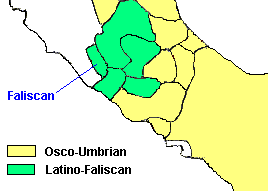 Faliscan
was the closest language to Latin, and that was
not fortunate for it, because it was the first to be assimilated and to
disappear from the map of Italy. Faliscans occupied a small land north
and east to Rome and were under Etruscan influence for a long time until
their two or three cities (Falerii, Faliscus and Ferentinus) were colonized
by Romans.
Faliscan
was the closest language to Latin, and that was
not fortunate for it, because it was the first to be assimilated and to
disappear from the map of Italy. Faliscans occupied a small land north
and east to Rome and were under Etruscan influence for a long time until
their two or three cities (Falerii, Faliscus and Ferentinus) were colonized
by Romans.
In the beginning of the AD era, nobody remembered Faliscan speech. Strabo depicting Central Italy writes the following (the only thing) about Faliscans: "[In Etruria] there are also plenty of small towns: Blera, Ferentinus, Falerii, Faliscus, Nepeta, Statonia and others... Some call Falerians not Tyrrhenians but a single tribe of Faliscans. Others consider Faliscus the town with its own language". That meant no one could point the exact place Faliscans used to live.
But several inscriptions and glosses of Faliscan language written in one of the Italic alphabets were found, and practically all of them show the language looked quite like Latin itself. Noun flexions (those found) were the same; Fliscan was moving towards similifications in verb conjugation - it sometimes loses the 3rd person singular -t ending. Faliscan vocabulary is mainly cognate with Latin with strong Etruscan substratum.